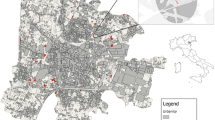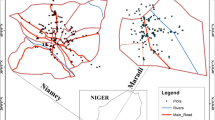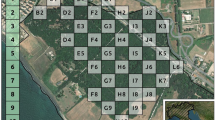Abstract
The present study is aimed at exploring native and alien plant species diversity patterns in distinct types of the urban forest environment by documenting differences in species density, level of invasion, and species-area relationships across four spatial scales (1, 10, 100, and 1,000 m2). The research was conducted in deciduous urban woodlands in Kyiv, Ukraine. The total set of sampling units (n = 60) was divided among three forest types representing semi-natural and planted woodlands. We observed significant differences in plant species diversity patterns between semi-natural and planted urban woodlands across structurally and functionally complex disturbance regimes. Specifically, broadleaved plantations had lower number of species at small spatial scales but steeper species accumulation within a designated area. Steep species accumulation resulted in a lack of differences with semi-natural forests at 100 m2 and 1,000 m2. Mesotrophic oak-hornbeam woodlands were relatively resistant to plant invasions. However, an existing pool of alien plant species coupled with a constant flow of newly arrived species at the city scale may create a sufficient propagule pressure to “break down” this resistance. Ash and poplar semi-natural forests occupied “an intermediate position”, not differing from oak-hornbeam forests and from deciduous plantations in terms of mean density of native and alien plant species, respectively. The multi-scale approach we applied in this study revealed the multifold aspects of plant species diversity patterns in the urban forest. We encourage a further development of plant diversity monitoring techniques that encompass multiple spatial scales and analyses.



Similar content being viewed by others
References
Alvey AA (2006) Promoting and preserving biodiversity in the urban forest. Urban For Urban Green 5(4):195−201
Antrop M (2004) Landscape change and the urbanization process in Europe. Landscape Urban Plan 67:9–26
Arrhenius O (1921) Species and area. J Ecol 9:95–99
Balvanera P, Pfisterer AB, Buchmann N, He J-S, Nakashizuka T, Raffaelli D, Schmid B (2006) Quantifying the evidence for biodiversity effects on ecosystem functioning and services. Ecol Lett 9:1146–1156
Barkman JJ (1989) A critical evaluation of minimum area concepts. Vegetat 85:89–104
Boncina A (2000) Comparison of structure and biodiversity in the Rajhenav virgin forest remnant and management forest in the Dinaric region of Slovenia. Global Ecol Biogeogr 9:201–211
Burda R, Golivets M, Petrovych O (2015) Non-nativeAlien species in the flora of the nature reserve fund of the flatland part of Ukraine. Russ J Biol Inv 6(1):6–20
Chocholouskova Z, Pyšek P (2003) Changes in composition and structure of urban flora over 120 years: a case study of the city of Plzen. Flora 198:366–376
Chytrý M, Pyšek P, Tichý L, Knollová I, Danihelka J (2005) Invasions by alien plants in the Czech Republic: a quantitative assessment across habitats. Preslia 77:339–354
Chytrý M, Jarosik V, Pyšek P, Hajek O, Knollová I, Tichý L, Danihelka J (2008) Separating habitat invasibility by alien plants from the actual level of invasion. Ecology 89(6):1541–1553
Chytrý M, Pyšek P, Wild J, Pino J, Maskelland LC, Vilà M (2009) European map of alien plant invasions based on the quantitative assessment across habitats. Diver Distrib 15:98–107
Cornelis J, Hermy M (2004) Biodiversity relationships in urban and suburban parks in Flanders. Landscape Urban Plann 69:385–401
Crawley MJ, Harral JE (2001) Scale dependence in plant biodiversity. Science 291:864–868
Davis MA, Grime JH, Thompson K (2000) Fluctuating resources in plant communities: a general theory of invisibility. J Ecol 88:528–534
DeCandido R, Muir AA, Gargiullo MB (2004) A first approximation of the historical and extant vascular flora of New York City: implications for native plant species conservation. J Torr Bot Soc 131(4):243–251
Dengler J (2008) Pitfalls in small-scale species-area sampling and analysis. Folia Geobot 43:269–287
Desmet P, Cowling R (2004) Using the species-area relationship to set baseline targets for conservation. Ecol Soc 9(2):1–23.http://www.ecologyandsociety.org/vol9/iss2/art11. Accessed 02 July 2014
Deutschewitz K, Lausch A, Kühn I, Klotz S (2003) Native and alien plant species richness in relation to spatial heterogeneity on a regional scale in Germany. Glob Ecol Biogeogr 12:299–311
Didukh Y (ed) (2000) Ecoflora of Ukraine, vol 1. Phytosociocentre Press, Kyiv, In Ukrainian
Didukh Y (ed) (2002) Ecoflora of Ukraine, vol 3. Phytosociocentre Press, In Ukrainian
Didukh Y (ed) (2004) Ecoflora of Ukraine, vol 2. Phytosociocentre Press, In Ukrainian
Didukh Y (ed) (2007) Ecoflora of Ukraine, vol 5. Phytosociocentre Press, Kyiv, In Ukrainian
Didukh Y, Alyoshkina UM (2012) Biotopes of Kyiv City. Kyiv-Mohyla Academy, Kyiv, In Ukrainian
Dolnik C, Breuer M (2008) Scale dependency in the species-area relationship of plant communities. Folia Geobot 43:305–318
Dzwonko Z, Loster S (1988) Species richness of small woodlands on the western Carpathian foothills. Vegetat 76:15–27
Field R, Hawkins BA, Cornell HV, Currie DJ, Diniz-Filho JAF, Guegan J-F, Kaufman DM, Kerr JT, Mittelbach GG, Oberdorff T, O’Brien EM, Turner JRG (2009) Spatial species-richness gradients across scales: a meta-analysis. J Biogeogr 36:132–147
Gleason HA (1922) On the relationship between species and area. Ecology 3:158–162
Godefroid S, Koedam N (2003) How important are large vs. small forest remnants for the conservation of the woodland flora in an urban context? Glob Ecol Biogeogr 12:287–298
Godefroid S, Massant W, Koedam N (2005) Variation in the herb species response and the humus quality across a 200-year chronosequence of beech and oak plantations in Belgium. Ecography 28:223–235
Grime JP (1998) Benefits of plant diversity to ecosystems: immediate, filter and founder effects. J Ecol 86(6):902–910
Grimm NB, Faeth SH, Golubiewsk NE, Redman CL, Wu J, Bai X, Briggs JM (2008) Global change and the ecology of cities. Science 319:756–760
Gustafsson L (2002) Presence and abundance of red-listed plant species in Swedish forests. Conserv Biol 16:377–388
Honnay O, Endels P, Vereecken H, Hermy M (1999) The role of patch area and habitat diversity in explaining native plant species richness in disturbed suburban forest patches in northern Belgium. Diver Distrib 5:129–141
Iida S, Nakashizuka T (1995) Forest fragmentation and its effect on species diversity in sub-urban coppice forests in Japan. Forest Ecol Manag 73:197–210
Jarošík V, Pyšek P, Kadlec T (2011) Alien plants in urban nature reserves: from red-list species to future invaders? NeoBiota 10:27–46
Jim CY, Liu HT (2001) Species diversity of three major urban forest types in Guangzhou City, China. Forest Ecol Manag 146:99–114
Kirby KJ (1988) Changes in the ground flora under plantations on ancient woodland sites. Forest 61:319–338
Klotz S (1990) Species/area and species/inhabitants relations in European cities. In: Sukopp H, Hejny S, Kowarik I (eds) Urban ecology – Plants and plant communities in urban environments. SPB Academic Publishing, The Hague, pp 99–103
Kowarik I (1995) On the role of alien species in urban flora and vegetation. In: Pyšek P, Prach K, Rejmanek M, Wade M (eds) Plant invasions – general aspects and special problems. SPB Academic, Amsterdam, pp 85–103
Kühn I, Brandl KS, Klotz S (2004) The flora of German cities is naturally species rich. Evol Ecol Res 6:749–764
Kühn I, Brandl R, May R, Klotz S (2003) Plant distribution patterns in Germany: will aliens match natives? Fedde Repertor 114:559–573
Laptev OO, Padun IM (2000) Analysis of the flora and the conditions of its existence in environment of a big city (Kyiv). Bulletin of Taras Shevchenko National University of Kyiv. Series: Biology 30:47–49, in Ukrainian
Lomba A, Vaz AS, Moreira F, Honrado JP (2013) Hierarchic species–area relationships and the management of forest habitat islands in intensive farmland. Forest Ecol Manag 291:190–198
McKinney ML (2006) Urbanization as a major cause of biotic homogenization. Biol Conserv 127:247–260
McKinney ML (2008) Effects of urbanization on species richness: a review of plants and animals. Urb Ecos 11:161–176
Millenium Assessment (2005) Ecosystems and human well-being: synthesis. Island Press, Washington DC
Mirkin BM, Naumova LG (2002) The vegetation adventization through perspective of current ecological ideas. J Gen Biol 63(6):500–508, in Russian
Mosyakin SL, Fedoronchuk MM (1999) Vascular plants of Ukraine: a nomenclatural checklist. M.G. Kholodny Institute of Botany, NAS of Ukraine, Kyiv
Mosyakin SL, Yavorska OG (2002) The non-native flora of the Kiev (Kyiv) urban area, Ukraine: a checklist and brief analysis. Urban Hab 1(1):45–65. http://www.urbanhabitats.org/v01n01/nonnativekiev_pdf.pdf. Accessed 01 March 2014
Murakami K, Maenaka H, Morimoto Y (2004) Factors influencing species diversity of ferns and fern allies in fragmented forest patches in the Kyoto city area. Landscape Urban Plan 70:221–229
Nowak DJ, Walton JT (2005) Projected urban growth (2000–2050) and its estimated impact on the US forest resource. J Forest 103:383–389
Pautasso M (2007) Scale dependence of the correlation between human population presence and vertebrate and plant species richness. Ecol Lett 10:16–24
Preston FW (1962) The canonical distribution of commonness and rarity I. Ecology 43:185–215
Proenca V, Pereira HM, Guilherme J, Vicente L (2010) Plant and bird diversity in natural forests and in native and exotic plantations in NW Portugal. Acta Oecol 36:219–226
Pyšek P, Pyšek A (1990) Comparison of vegetation and flora of West Bohemian towns. In: Sukopp H, Hejny S, Kowarik I (eds) Urban ecology–Plants and plant communities in urban environments. SPB Academic Publishing, The Hague, pp 105–112
Pyšek P, Jarosík V, Kucera T (2002) Patterns of invasion in temperate nature reserves. Biol Conserv 104:13–24
Ranta P, Viljanen V (2011) Vascular plants along an urban–rural gradient in the city of Tampere, Finland. Urb Ecos 14:361–376
Rosenzweig ML (1995) Species diversity in space and time. Cambridge University Press, Cambridge
Rudnicky JL, McDonnell MJ (1989) Forty-eight years of canopy change in a hardwood-hemlock forest in New York City. J Torr Bot Soc 116:52–64
Schmida A (1984) Whittaker’s plant diversity sampling method. Israel J Botan 33:41–46
StatSoft Inc. (2001) STATISTICA for Windows Version 6.0. StatSoft, Inc., Tulsa
Stewart GH, Ignatieva ME, Meurk CD, Earl RD (2004) The re-emergence of indigenous forest in an urban environment, Christchurch, New Zealand. Urban For Urban Gree 2:149–158
Trentanovi G, von der Lippe M, Sitzia T, Ziechmann U, Kowarik I, Cierjacks A (2013) Biotic homogenization at the community scale: disentangling the roles of urbanization and plant invasion. Diver Distrib 19:738–748
Veech JA (2000) Choice of species-area function affects identification of hotspots. Conserv Biol 14:140–147
Wania A, Kühn I, Klotz S (2006) Plant richness patterns in agricultural and urban landscapes in Central Germany – spatial gradients of species richness. Landscape Urban Plan 75:97–110
Williams JW, ReVelle CS, Levin SA (2005) Spatial attributes and reserve design models: a review. Environ Model Assess 10:163–181
Zipperer WC, Guntenspergen GR (2009) Vegetation composition and structure of forest patches along urban–rural gradients. In: McDonnell MJ, Hahs AK, Breuste JB (eds) Ecology of cities and towns: a comparative approach. Cambridge University Press, New York
Acknowledgments
I am sincerely thankful to Dr. Kimberly Wallin, Sarah Pears, and two anonymous reviewers for valuable comments and suggestions on the manuscript.
Author information
Authors and Affiliations
Corresponding author
Electronic supplementary material
ESM 1
(PDF 344 KB)
Rights and permissions
About this article
Cite this article
Golivets, M., Bihun, Y. Patterns of plant species diversity in deciduous woodlands of Kyiv, Ukraine. Urban Ecosyst 19, 489–503 (2016). https://doi.org/10.1007/s11252-015-0485-1
Published:
Issue Date:
DOI: https://doi.org/10.1007/s11252-015-0485-1




